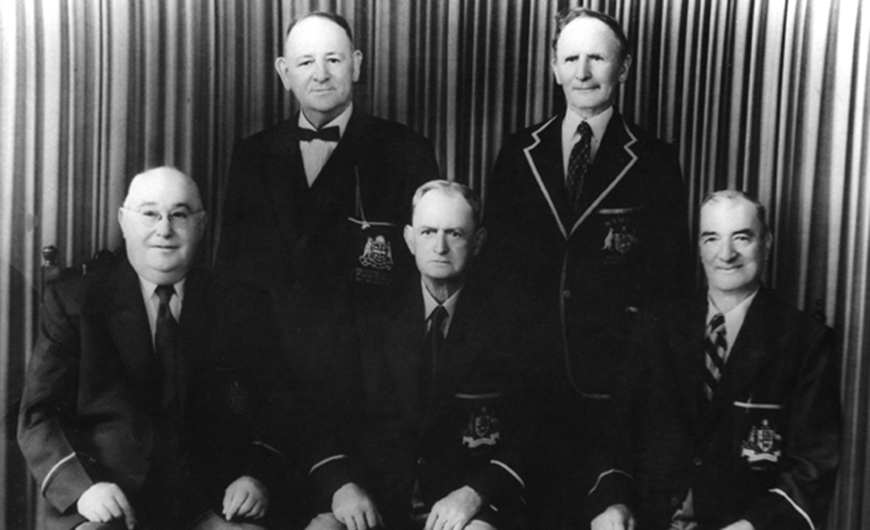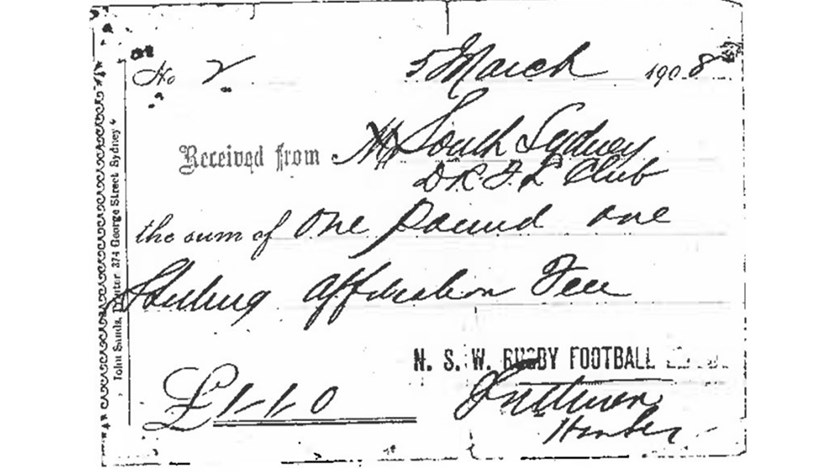FOUNDERS OF THE RABBITOHS
The South Sydney Rugby League Football Club was officially the third rugby league club to be formed in Australia on 17 January 1908, after Glebe (9 January) and Newtown (14 January) were formed. But our initial formation goes back to September 1907 when Arthur Stephen Hennessy organised a meeting to form the club at his house in 9 Chapman Street, Surry Hills.
He sent out letters to all rugby clubs in the district inviting interested parties to attend. The response was less than overwhelming, with George Ball, Billy Cann and Johnny McGrath being the only ones present with Hennessy, while Ed Fry sent his full support behind the new club and an apology for not being able to attend owing to a previous engagement.
Hennessy, Cann and Fry were the three local players who had taken part in the three matches against the NZ All Golds, which were all played under rugby union rules because the Northern Union rule book didn’t arrive by boat from the UK until January 1908.
The seeds of our club were first sprouted at this meeting by the five brave men who were the real Founders of our grand old club, and in December 1955 Souths commissioned a photo to be taken of the five men. This photo was proudly displayed in the offices of the old Souths Leagues Club.

A number of other meetings were convened during the spring and summer of 1907-08 to form the district club, and the co-founders also helped in organising fliers across the South Sydney district which read: “SOUTH SYDNEY – all footballers in this district should join this club for these reasons; play for yourself and your club’s advantage or play for the Union to their advantage, and no return to yourself. Savee?”
But despite those humble beginnings, the small band of believers managed to garner more and more support, culminating in an historic meeting at Redfern Town Hall on 17 January, 1908 where South Sydney was officially formed. One of the documents held by the NSW Rugby League is the receipt signed by J.J. Giltinan which lists Souths as the number two affiliated club with the NSWRL (North Sydney were the first to affiliate).

In a 1931 interview, George Ball said of that night in 1908: “The attendance was excellent, quite a number of those present, no doubt, being attracted to the meeting out of curiosity, as much had been written in the press concerning the new code and the likelihood of disqualification from the Rugby Union of anyone who had the temerity to join up with the New Movement.”
Despite strong initial opposition from those who continued to support rugby union, the club made significant progress, with regular training sessions being held at Moore Park, where the players were taught the rules of Northern Union football. On 21st March 1908 Souths had the distinction of playing the first football game under North Union rules in Australia, when a trial was organised between Souths’ Possibles against Souths’ Probables at the Sir Joseph Banks’ Ground, Botany. The game was played as 12-a-side, probably because the club only had 24 players on their books at the time. George Ball hired the ground for the day, which cost the club half a guinea.
A month later on Easter Monday the first round of the NSWRL competition was played at Birchgrove Oval, with Souths defeating Norths by 11-7.
ARTHUR STEPHEN HENNESSY (1876-1959) (a.k.a. The Father of South Sydney)
A regular Souths rugby union first grade forward in 1900-07 (94 games, scoring 5 tries), he toured New Zealand in 1901, and represented New South Wales against Queensland in 1904.
He was Souths’ first captain in the new code and was also named the club's first delegate to the NSWRL. His policy of 'no kicking' at the club earned South Sydney the title 'The Pride of the League' with their running and passing style of play. He also captained NSW in their first interstate match before being named Australia’s inaugural Test captain in the series against New Zealand. When clubs and representative sides began to list their players in chronological order, as had been the case in cricket, Hennessy held the unique honour of being Number One on the Rabbitohs player register, as well as NSW Blues and the Australian Kangaroos.
Hennessy had quickly absorbed the principles of the new code and became a sought-after coach; in 1911 he trained the Wyalong team. As NSW coach of the 1913 touring side to New Zealand he imposed a steak-only diet for lunch on match days. Hennessy strongly advocated the no kick principle, emphasizing the importance of ball possession to score tries. This came to be the mark of South Sydney's football, influenced by Hennessy as head trainer in 1912-13.
He was amongst the first pioneers to be inducted as a Life Member of the New South Wales Rugby League in 1908.
During the 1920s Hennessy was a football and boxing coach at Waverley College. He was a non-playing coach of the 1929-30 Kangaroo tour of Britain, the first and only such appointment until Clive Churchill's in 1959. Hennessy prohibited kicking and the Australians were narrowly defeated. He coached Country against City in 1942-44, and Souths' firsts in 1946; about then he also published a coaching manual, “Winning Rugby Moves”.
‘The Father of South Sydney’ died on 19 September 1959 at Maroubra, aged 82, and was buried with Anglican rites in Botany cemetery.
SAMUEL GEORGE BALL (1884-1969)
George Ball was Souths’ pioneer administrator and a remarkable figure in the development of the South Sydney Club and the growth of rugby league in the 20th century. He was a man of calm disposition and solid judgement, and he had seen his beloved Rabbitohs, and the League, grow through the years to remarkable success.
Mr Ball began his administrative career in 1900 as secretary of the Waterloo Albions rugby union side, which played in the junior competition. When the South Sydney club was officially formed in 1908 Mr Ball became Hon. Treasurer of the Club, and stayed in office until the following year. From there his duties included: Delegate to the League in 1909-66, Club Secretary in 1910-66, General Committee in 1943-57, Retention Committee in 1950-65, Private Member Reviewing Committee in 1950-66, Social Committee in 1950-66 and Members’ Reviewing Committee in 1963-66.
Mr Ball was the first Secretary of the Australian Board of Control and was for many years a NSW representative on that body. He also served as manager of NSW sides to Queensland and New Zealand and managed the 1921 Kangaroo tour with clubmate, Billy Cann, the only time any club has had such an honour. He became one of the cornerstones of the game until stepping down from all duties on 12th April 1966.
Mr Ball was inducted as a Life Member of the NSWRL in 1914, and he was one of 14 people who were the first to be inducted as Life Members of the South Sydney Football Club at the 54th Annual General Meeting held at Redfern Town Hall on 6th February 1962.
His wife Alice Pearce was a champion swimmer and she was Sid ‘Sandy’ Pearce’s sister. The Pearce family were a famous swimming, sculling, boxing and footballing family. The junior representative competition, SG Ball Cup, was named after George Ball and has been in existence since 1965.
Mr Ball was also the first to make this famous remark: "Let those who drink the water remember those who dug the well", in relation to spiraling wages that some players were earning and continue to do so.
Mr Ball died on 26th August 1969 at Double Bay, aged 85, and there were many fine tributes given to him after his death. But none summed up everyone's feelings towards this truly great statesman as the one given by Bill Buckley, OBE (President of the Australian and NSW Rugby League) when he said: "George Ball was of fine character and a wonderfully sound administrator. I have never known a better one in League affairs."
WILLIAM ASKEW CANN (1882-1958)
Younger brother of Sydney Cann, who played for Souths’ Third Grade in 1909.
Former rugby union three-quarter with Souths in 1905-07 (playing 20 games, scoring 5 tries), Billy Cann was a member of the rebel NSW side that played the NZ All Golds in 1907. He made his first grade rugby league debut with Souths in 1908, Round 2 v Western Suburbs at the Agricultural Ground, scoring two tries on debut.
Mr Cann went on to become both an innovative player and long-serving administrator with Souths. A pioneer of lock forward play, he was also elected as the club's first committeeman in 1908 as well as Souths’ delegate to the NSWRL. Cann’s creativity in ‘loose’ play shaped the role of the lock in the professional code and he combined brilliantly with his backline. He took part in Australia’s inaugural Test series, against NZ in 1908, and was a member of the 1908-09 Kangaroos (8 matches, no Tests) and the 1911-12 ‘Australasian’ Kangaroos (18 matches, 3 Tests).
Mr Cann also played against NZ (1909) and England (1914) during his international career and although he missed Souths’ first premiership final because he was on tour, he later played an important part in the club’s title wins in 1909 and 1914.
He was inducted as a Life Member of the NSWRL in 1908. Following his retirement Mr Cann was co-manager of the 1921-22 Kangaroos with Souths secretary George Ball - the only time that officials from the same club have been in charge of a touring team.
During the 1940s and 50s, Cann was a vice-president of the NSWRFL. He was also an SP bookie and for many years wrote articles for The Sydney Morning Herald.
Mr Cann died on 7th June 1958 at Harbord after a short illness, aged 75.
JOHN JOSEPH McGRATH (1884-1966)
Mr McGrath took over from George Ball as Souths’ Treasurer in 1910 and stayed in that role until 1917. The following year he became Club President until 1924, as well as Hon. Auditor from 1918-19 and then club Delegate to the League in 1920-22.
Mr McGrath was inducted as a Life Member of the South Sydney Football Club at the 89th Annual General Meeting held at the South Sydney Leagues Club in Redfern on 8th December 1963.
He died on 15th June 1966 at Kensington, aged 82.
EDWARD STEPHEN FRY (1878-1968)
Brother of James Fry (who played rugby union for Souths in their very first game in 1900), Fred Fry (who played rugby league for Easts), and Bill Fry (who also played rugby league for Souths).
Edward played first grade rugby union for Souths in 1902-07, playing in 62 games (scoring 9 tries and 2 field goals). He was also a member of the NSW Pioneers team who played against NZ All Golds in three games back in 1907.
He made his first grade debut in rugby league in the very first game played in 1908 against North Sydney at Birchgrove Oval. He was also the Vice-Captain of the side and captained the first grade team in 5 games, including the Final against Eastern Suburbs, which Souths won by 14-12 to claim their first premiership victory.
Mr Fry also played representative football with the Probables in 1908 and 2 games for NSW against the Queensland side in 1908. When his playing career ended in 1908, the loyal clubman continued at Souths in many different roles: on the Committee in 1909-32, Vice-President in 1911-19, 1921 and 1927-46 as well as Hon. Auditor in 1920-68.
He was inducted as a Life Member of the NSWRL in 1908, and also as a Life Member of the South Sydney Football Club at the 55th Annual General Meeting held at Redfern Town Hall on 5th February 1963.
He died on 27th March 1968 at Rockdale, aged 89, after a long illness.






















































